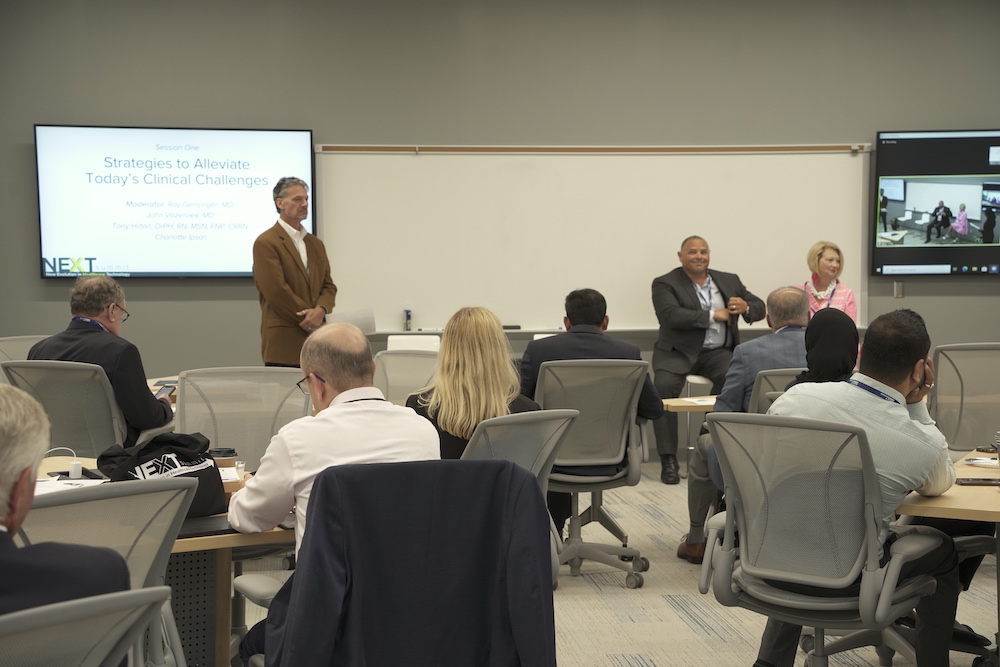The first panel at the NEXT Summit on August 5, focused on how clinical leaders can overcome the many challenges facing their teams including understaffing, improving and expanding quality care, and creating efficiency within and between healthcare teams.
Moderator: Ray Gensinger, MD - CIO, Hospital Sisters Health System
Panelists:
- John Vozenilek (Dr. Voz), MD - FACEP, VP and CMO, Simulation, Professor of Medicine and Engineering
- Tony Hilton, DrPH, RN, MSN, FNP, CRRN - Safe Patient Handling and Mobility National Program Manager, Veterans Health Administration Central Office
- Charlotte Ipsan - Chief Administrative Officer, Norton Women's & Children's Hospital
Dr. Gensinger, previously identified as an HIT Innovator of the Year by Healthcare Informatics, kicked off the session by pointing out the essential nature of innovation and the continuous reinvention of health and healthcare. "Healthcare as an industry cannot sustain itself in the existing trajectory! Modernization and digitization of our services is going to require an essential transformation and these leaders here are helping lead the way."
The discussion throughout the session focused on how continuous training of on-the-floor staff members—from housekeeping to clinicians—is essential. Dr. Voz noted that training needs to be an immersive experience, where real-world scenarios play out and quick decisions need to be made. These labs can include augmented reality and hands-on training in a simulated environment.
“You need a clinical context in simulation training.”
As a result of the ongoing COVID crisis, healthcare systems have rapidly adopted new systems to work through a crisis but Dr. Hilton added that we can’t wait for the next crisis. "We have to plan now and be prepared to act. There has to be evidence behind why we’re choosing the modalities we’re choosing and what we can do better.”
Part of the problem that was discussed is that infrastructure—especially in older buildings—can be a literal barrier when it comes to patient safety. But that’s not to say you can’t recreate these environments and have simulation training allowing clinicians to make quick decisions and make mistakes in a safe environment. This is something the VA has been practicing for years and it’s paid off. “The leadership has invested in technologies and systems to protect and preserve our staff. Our staff injury rate has dropped by 50% in the last ten years and it directly impacts longevity and retention,” Hilton noted.
Ipsan reported that Norton recently invested significantly in the renovation in one of its buildings. The planners invited all the end-users—housekeeping, food services, and clinicians—to help them design the room plan so they were taking less steps to decrease possibilities for injuries to staff and patients. “Through these updates and by taking an innovative approach, we are providing a new level of care that is enhancing a patient’s experience.” she said. All of the panelists agree that you need buy-in from these key stakeholders to provide meaningful data.
Dr. Hilton also stressed the need to invest in technologies and tools to prevent injuries. At the VA she cited workers' compensation costs that can be as much as half a million dollars a day, from injuries incurred that are preventable. She said, "How can you say you don’t have money for technology investments/purchases to prevent this? We are living in a High Reliability Organization (HRO) environment that focuses Zero Harm to all. Staff will be more willing to report injuries if they are not penalized or discouraged from reporting even minor injuries as well as any close calls. The business case for SPHM programs/technology is overwhelming that prevention is better than cure.”
Investing wisely in simulations and technology solutions can save your organization hundreds of thousands of dollars and create efficiencies for your clinical staff.


